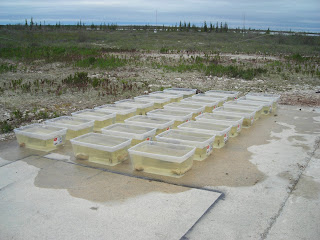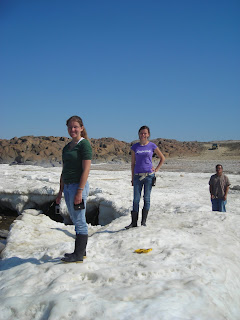Friday, June 25, 2010
A note to add about the microcosms
Sunday, June 20, 2010
Solstice and kids
But back to the great day. Today myself, Emily, Liz and Jinjing (fellow Guelph researchers) had the opportunity to visit a grade 3 class at the Duke of Marlborough school in town. We spent the morning gathering some plants, willow catkins, caterpillars, aquatic insects and of course zooplankton to show the students. The grade 3's just finished units about soils and plant growth and were eager to see all of the critters we brought in.
Liz explained how many aquatic insects make protective cases out of materials they find in the water and was able to show cases made of grasses, other plants, twigs and rocks. Emily showed how larvae use plants and specifically willow catkins to make their homes and explained how she is currently rearing several different species of caterpillars. I showed my groups several different types of zooplankton, explained how they overwinter, what they eat and taught the students how to focus on the small organisms under a microscope. The kids were all very eager to participate, from the student who told me all about krill to a student who insisted on showing all the other kids how she learned to focus the microscope.
The end of the session was spent playing a game simulating competition between animals for different habitats and resources. Overall a very fun afternoon and a great opportunity for us to share some of our science! Thanks to LeeAnn for setting up this chance for us, to Liz for the organization as well as to the students and their teacher for welcoming us into their classroom!
The experiments have begun.


Like Da Bluff, this site is also frequented by Da Bunny (although I doubt it is the same one we spotted frequently last year).

Basically, I have extracted ephippia (see my previous post) from various habitats, cold shocked them and then rapidly dried and rehydrated them to induce emergence (simulating the passage of a winter season). Now I have put them into small microcosms under various salinity conditions and will monitor emergence. In addition to control microcosms there are three other aspects that I am testing.

Thursday, June 10, 2010
Getting here...1 planktoneer arrived...2 to go
 (Map from VIA's website).
(Map from VIA's website). Here I attempt to share one an early morning scene on the tracks, just outside of Capreol, Ontario.
Here I attempt to share one an early morning scene on the tracks, just outside of Capreol, Ontario.Guelph is about 1957 km from Churchill...but of course that distance is if you could travel in a straight line. The actual distance travelled by train takes in a few more turns.While some of these km may seem desolate, the history of the train line is far from sparse. At rest stops along the way I was able to learn a little more about the railway. For instance, I learned that starting in the early 1900s, most railway stations had elaborate railway gardens, set up as showpieces that would be the first thing passengers would see as they entered a new community. The point of this was to encourage passengers in rural parts of Canada. I enjoyed the train and really do feel that it is a method of transportation worth supporting.
Since arriving in Churchill, I have delved into another research season as a planktoneer...
(Photo: taken by Krista Hanis)
and have been slowly been regaining my bluff legs. As a recap, my project focuses on freshwater zooplankton communities along the coast of Hudson Bay and how they respond to changes in environment, most notably, the saltiness or salinity of the water. This year I am really interested in how the resting stages of zooplankton ( for example, this Daphnia ephippia below- I also like describe them as dumplings) may impact zooplankton's ability to recover from disturbance and stress.
 The pouch like things pictured above are essentially dormant eggs released by mature Daphnia. And this is how our spotlight on travel fits in...Last year I spent a lot of time thinking about how zooplankton might "commute" around the rock bluffs without thinking much about the idea that sometimes it is easier to stay put and just wait out unfavourable environmental conditions- more on this later.
The pouch like things pictured above are essentially dormant eggs released by mature Daphnia. And this is how our spotlight on travel fits in...Last year I spent a lot of time thinking about how zooplankton might "commute" around the rock bluffs without thinking much about the idea that sometimes it is easier to stay put and just wait out unfavourable environmental conditions- more on this later.
Well my arrival back at the CNSC has been filled with science, catching up with friends from last year and enjoying some very hot spring weather. I'm looking forward to the rest of the summer and many more planktoneer adventures in this place where there is always more to learn.
Below are some pictures of some coastal exploration with some of the other researchers from Guelph: Liz, Emily and Jinjing.



 This is a specially crafted snowball...it has pieces of ice for extra protection...
This is a specially crafted snowball...it has pieces of ice for extra protection...Tuesday, June 1, 2010
Public service announcement
The Three Planktoneers (some old, some new) will be returning to Churchill this summer...stay tuned!